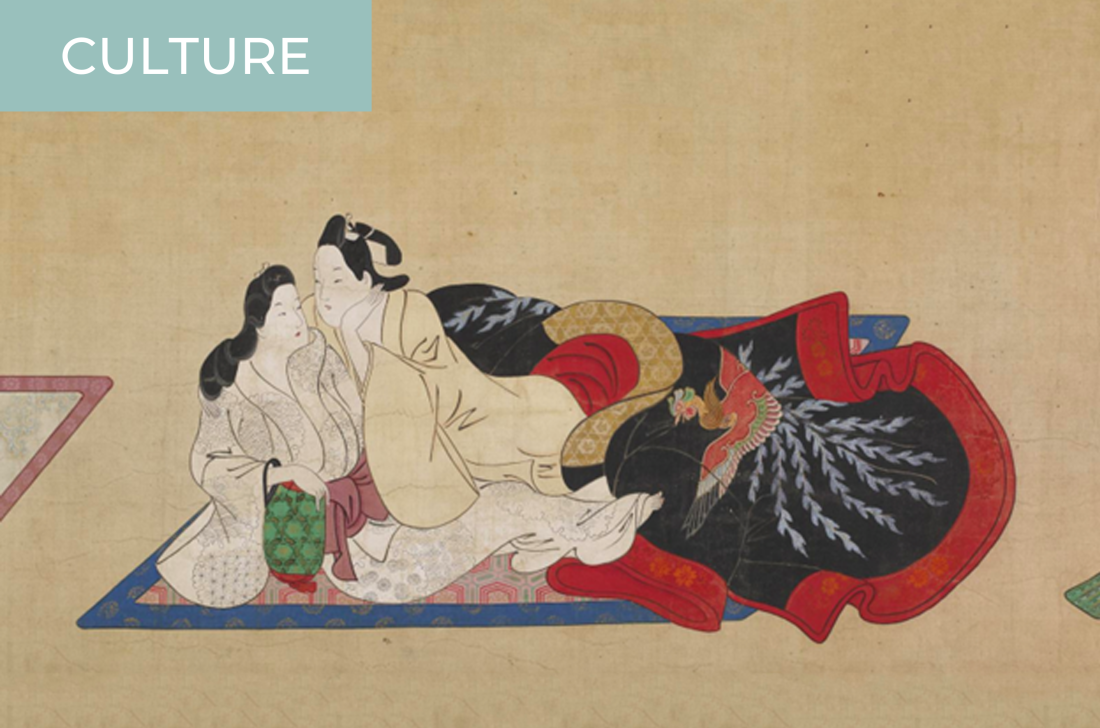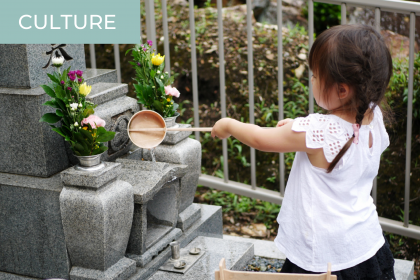Today I’m going to talk about shunga, or Japanese erotic art, with hundreds of years of history. Now, before I begin, bear in mind the nature of this highly sexual topic. By modern Western standards, this content might not be safe for work or family-friendly, although any explicit images I’ll link and tag with “[click warning]” below.
Look up images of shunga, and you’ll likely see Japanese couples from yore in the throes of passion, often in contorted positions and with wildly oversized genitalia. Or perhaps, that oversized genitalia is a part of a courtly acrobatic penis competition. But wait, there’s more! The scroll depicting this competition [click warning]–believed to have possibly been drawn first by a Buddhist monk–also later portrays outrageous farting battles. Another famous work by the renowned woodblock artist Hokusai depicts a massive octopus pleasuring a woman [click warning] (perhaps the origin of the infamous Japanese subgenre of tentacle porn).
You might feel intrigued, shocked, or amused. And actually, that’s often exactly how you were intended to feel. Shunga had several roles in pre-modern Japanese society: as a form of entertainment, education, advertisements, humorous political commentary, and even sometimes as a mystical protector against injury and fire. Shunga works offer a fascinating insight into Japanese society before the modern era. (And if you’re a shunga nerd like me, you’ve read the entire academic journal issue all about it cover to cover–in the links below.)
Former Attitudes toward Sex in Japan
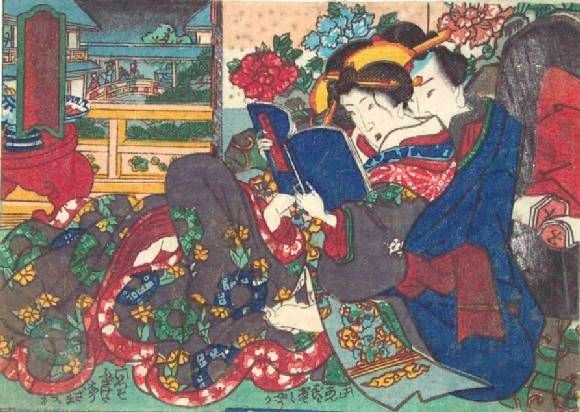
While the popular term “shunga” (春画) literally means “spring pictures,” other terms include 笑本 (ehon) and 笑絵 (warai-e). You’ll notice both include the kanji 笑, which today means “laughter.” However, in pre-modern Japan, this kanji character also could mean “masturbation.”
In Japan, sex and “self-love” had traditionally been viewed as a natural part of life. Relative to today, in pre-modern Japan, sexual activity had not been seen as something embarrassing or immoral. In general, attitudes toward sexual activity were quite blunt, and possessing shunga was not shameful. For example, there are records of Japanese shunga-owners proudly showing off their prized shunga collection to appalled Westerners visiting the country. Looking at shunga was something you could do together. You’ll find many shunga prints depicting both genders–and sometimes even pre-teen children–masturbating. Have you ever heard of the legend of Izanami and Izanagi, the two gods who created Japan? Well, the story goes that they actually created the Japanese archipelago through masturbation and intercourse. This might not have been a detail taught to you in Japanese class.
Sex and Power Relations in Pre-Modern Japan
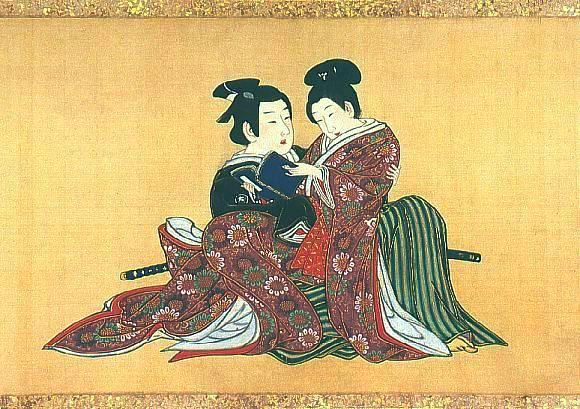
Now, don’t get me wrong, Japan was not all about free love. Sex was actually something incredibly hierarchical and tightly controlled in some cases, and this is believed to be partially responsible for certain booms in shunga consumption. Edo Period (1603-1867) Japan required regional feudal lords (daimyo) to spend alternative years between their home of residences and Edo, the capital, which later became Tokyo. This system, called Sankin-Kotai (参勤交代), was meant to ensure the shogun (ruler)’s dominance over the daimyo. In essence, the daimyo’s wives and families were held hostage while they were away. Suffice to say, Edo, believed to be two-thirds men, was nicknamed the “city of bachelors,” and shunga consumption was incredibly high during this period. Although it’s believed that more men consumed shunga than women, it was not exclusively a male product. For example, it is also believed to have offered release for upper-class wives and concubines leading restricted (and, in part due to the prevalence of polygamy, often sexless) lives.
This dynamic of sexualized power relations goes beyond “straight” relationships as well. By looking at shunga, we can also learn a lot about Japan’s former attitudes toward LGBTQ matters–although it would not have labeled orientations as such. What I mean is this: Until relatively recently, Japan did not have the same homosexual versus heterosexual binary as it does now. This is actually a Western cultural import. Which gender you slept with could be viewed more as a habit or a taste, not as an identity. And these preferences could change over time. Shunga prints depict many instances of male-male sex (and, to a lesser extent female-female sex). Many famous male figures in Japanese history routinely slept with other men as well as women. There were even specific words for male-male sex (nanshoku), men who avoided sleeping with women (onna-girai), and men who avoided sleeping with men (nanshoku-girai). In particular, nanshoku (男色) relationships were very closely related with power relationships, since they were permissible if the receiving partner were younger. Granted, however, we know much less about such female relationships, as they have been largely ignored in the documentation.
Shunga’s Other Core Functions in Japanese Society

In addition to fulfilling the role of modern-day pornography, shunga also served as promotions for kabuki actors–who sometimes performed sexual services–or famous prostitutes. As such, prints sometimes were like modern-day collectible cards–just sexual. While not everyone who had their shunga prints could afford their services, in some cases, they were almost like a calling card. In these cases, the wealthy could summon the actor or prostitute in question.
Ironically, today, you’ll be hard-pressed to find many shunga prints in Japan. In fact, many scholars have had to conduct their research outside of Japan due to its censorship laws, which tightened toward the end of the Edo Period. There were multiple reasons for this. For one, remember how I mentioned shunga were sometimes used for satire? Well, satire can be a powerful medium. High-powered lords and officials did not enjoy being laughed at for being depicted in often humorous sexual material. Shunga sometimes caused quite a scandal in elite society. In addition, things changed when Americans and Europeans entered Japan. The Victorian-era West likewise felt scandalized by the open attitudes toward sex and shunga. As a result, in an effort to curry favor with the West, Japan started propagating that shunga was responsible for corrupting morals and other social woes.
Final Thoughts and Sources
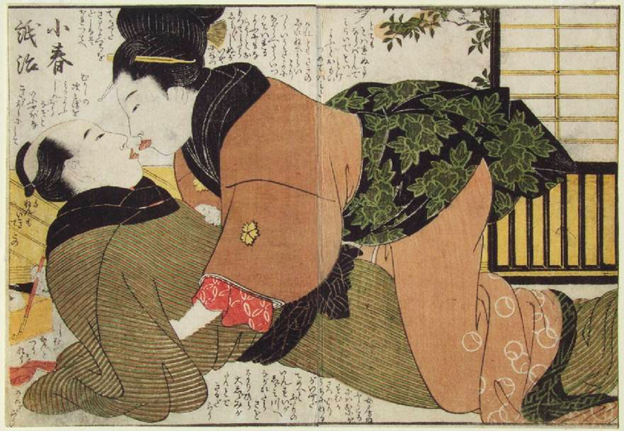
Although popular modern-day attitudes tend to view shunga as nothing more than old-timey pornography, it was so much more. Yes, it could serve as sexual stimulation. But it also provided comic relief, social commentary, and accumulation of wealth. Japan for sure has changed a lot over the last couple hundred years.
If you want to learn more about shunga, here are some recommended sources I used for this research:
- Sex and the Floating World by Thomas Screech
- Japan Review (Journal of International Research Center for Japanese Studies), no. 26 special issue: “Shunga: Sex and Humor in Japanese Art and Literature”
Top picture credit: Wikimedia Commons

